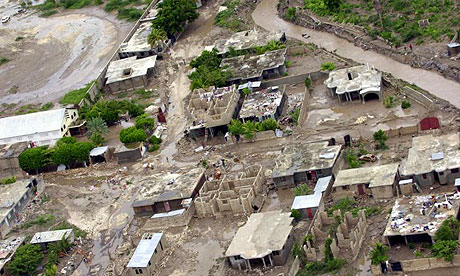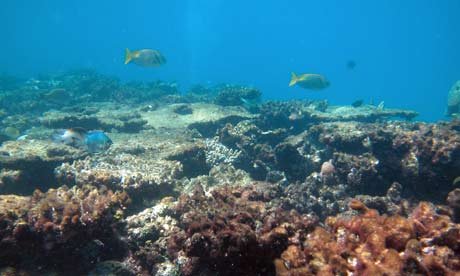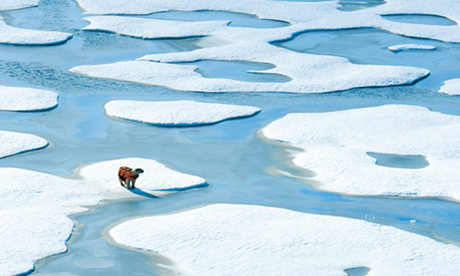In the third part of our series on the eve of the Poznan conference, we look at how climate change is already changing ordinary people's lives from Australia to Brazil
- The Guardian, Wednesday December 10 2008
- Article history

An aerial view of Gonaives, in Haiti, after the passing of tropical storm Hanna. Photograph: Thony Belizaire/AFP/Getty images
Joao da Antonio's eyes are full of tears. If good rains do not come, he says, he will pack his bag, kiss his wife and two children goodbye and join the annual exodus of young men leaving hot, dry rural north-east Brazil for the biofuel fields in the south.
Da Antonio, 19, can earn about £30 a month for 10 hours gruelling work a day cutting sugar cane to make ethanol, and more than a million small farmers like him migrate south for six months of the year because the land can no longer support them. Tens of thousands a year never return, forced to move permanently to Sao Paulo or another of Brazil's cities in search of work.
"Life here is one of suffering," Da Antonio said. "I will do anything to earn some money. None of us want to die, but the lack of water here will kill us. "
Around the world, millions of people like Da Antonio are feeling the force of a changing climate. As UN negotiations towards a global climate deal continue in Poznan, Poland, this week, evidence is emerging of weather patterns in turmoil and the poorest nations disproportionately bearing the brunt of warming.
While rich countries at the talks seek to set up global carbon trading, using financial markets to tackle - and profit from - climate change, poor countries want justice. They are seeking environmental justice: money to adapt their economies to climate changes they did not cause, and technology and resources to allow them to escape poverty while preserving their forests and ecosystems.
The fast and unpredictable shifts in weather are not threats for the future, but happening right now. "The frequency of heatwaves and heavy precipitation is increasing; cyclones are becoming more frequent and intense; more areas are being affected by droughts; and flooding is now more serious," says Sheridan Bartlett, a researcher with the International Institute for Environment and Development in a new study looking at the effects of climate change on children.
"Increasingly unpredictable weather now affects hundreds of millions of farmers, resulting in food and water shortages, more illnesses and water-borne diseases, malnutrition, soil erosion, and disruption to water supplies," she says. Such changes confound the received wisdom of how to live on the land.
North-east Brazil has always known droughts, but they are becoming longer and more frequent, say scientists and farmers. "Climate change is biting. It is much hotter than it used to be and it stays hotter for longer. The rain has become more sporadic. It comes at different times of the year now and farmers cannot tell when to plant," says Lindon Carlos, an agronomist with Brazilian group Acev.
Brazilian scientists have recorded changes in the lifecycles of plants, greater oscillations in temperature and more water shortages, all consistent with the UN Intergovernmental Panel on Climate Change (IPCC) predictions of a devastating 3-4C rise in temperatures within 60 years if climate change is not halted. "All the research points to it becoming drier [in north-east Brazil]. In the last 30 years temperatures have risen by 1C. There is more very heavy rainfall over short periods and more evaporation," says Eneida Cavalcanti, a desertification specialist at the Joaquim Nabuco foundation in Recife.
On the other side of the world, the changing climate is wreaking havoc in a different way on low-lying and populous Bangladesh. There, government meteorologists this year reported a 10% increase in intensity and frequency in major cyclones hitting the country - two of the most powerful cyclones ever recorded have hit the country in the last three years.
"We are getting too much water in the rainy season and too little in the dry season. All this has implications for food security," says Raja Debashish Roy, Bangladesh's environment minister.
"We are learning about climate change," said Anawarul Islam, chair of the Deara district of about 2,500 people in the far south of the county. "This village is experiencing more rainfall and flooding every year. It has led to more homeless people and more conflict. "
"It's far warmer now," says one villager, Selina. "We do not feel cold in the rainy season. We used to need blankets, but now we don't. There is extreme uncertainty of weather. It makes it very hard to farm and we cannot plan. We have to be more reactive. The storms are increasing and the tides now come right up to our houses."
The balmy Caribbean is also being churned up with increasing frequency and ferocity. This year, the region experienced eight hurricanes and five major hurricanes, the second highest ever, and the hurricane season lasted a record five months.
"A warmer climate poses in some cases insurmountable challenges to the region. We face more hurricanes, coral bleaching and flooding," said Neville Trotz, science adviser to the Caribbean community climate change centre.
Across the Atlantic, in Africa, the theme unfolds further: climate change turning already bad situations in poor countries into potential catastrophe, and driving people to absolute poverty. Alexandre Tique, at Mozambique's national meteorological institute, says: "Analysis of the temperature data gathered in our provincial capitals, where we have meteorological stations that have kept continuous data over the years, shows a clear increase in temperature. Extreme events are becoming more frequent. We now see many more tropical cyclones that bring flooding, destruction and loss of lives."
Other African communities are suffering. In the village of Chikani, in Zambia, the farmers last year prepared their fields for planting in November, as they have always done, but the rains were very late for the third year running.
"We waited, but the first drop didn't fall till December 20. After a day, the rains stopped. Three weeks later, it started to rain again. But then it stopped again after a few days. Since then, we have had no rain. We have never known anything like this before," says Julius Njame.
From the plains of Africa, to mountaintop Nepal, where there is no respite from the weather in flux. Villages like Ketbari expect a small flood to wash off the hills every decade or so, now they seem to be annual and getting more serious.
"We always used to have a little rain each month, but now when there is rain it's very different. It's more concentrated and intense. It means that crop yields are going down," says Tekmadur Majsi, whose lands have been progressively washed away by the Trishuli river.
Nepalese villagers observe the minutiae of a changing climate. Some say that forest pigs now farrow earlier, others that some types of rice and cucumber will no longer grow where they used to. The common thread is that the days are hotter, some trees now flower twice a year and the raindrops are getting bigger.
The anecdotal observations of farmers are backed by scientists who are recording in Nepal some of the fastest increases in temperatures and rainfall anywhere in the world. Many lakes in Nepal and neighbouring Bhutan, which collect glacier meltwater, are said by the UN to be growing so rapidly that they could burst their banks.
Melting glaciers are creating anxiety about water supplies across the Earth. In Tajikistan, at current rates of change, thousands of small glaciers will have disappeared completely by 2050, causing more water to flow in spring followed by what is expected to be a disastrous decline of river flow in most rivers. In Peru, temperature increases have led to a 22% reduction in the total area of its glaciers in the last 35 years.
The developing nations on the climate frontline will argue strongly in Poznan that rich countries should pay to help them adapt to climate change. But development groups such as Oxfam and Tearfund say that almost all the money pledged so far has come out of existing aid funds. With a worldwide recession, many analysts expect rich countries to resist paying more.
The UN has established two funds - the Least Developed Countries and Special Climate Change funds - to raise money for the poorest countries to adapt, but the G8 countries have only pledged $6bn (£4bn). All the money is to be diverted from existing aid money.
"Every [official development assistance] dollar that goes to climate adaptation would mean a dollar less for health and education [programmes] in developing countries," said Antonio Hill, a senior policy adviser at Oxfam.
The scale of what is needed for adaptation is immense. Bangladesh says it needs £250m over three years to adapt, Ethiopia £450m, and other countries similar amounts. Development groups estimate that a minimum $50bn a year is needed worldwide.
"The resources currently available for adaptation are grossly inadequate to meet the needs of the least developed countries who bear the brunt of increased climate variability and unpredictability resulting from climate change," said Bangladesh's finance minister, Mirza Azizul Islam.
Back in north-east Brazil, the Pernambuco state environment minister, Aloysio Coasta, says: "In 20 years' time we could be a desert region. In some communities there are no young people left at all. This is an emergency. Food production is going down in many areas."
Joao da Antonio's wife, Luiza, is resigned to becoming a "drought widow". Clearly distressed, she says: "If there is no water, then he must leave."



 View Larger Image
View Larger Image










